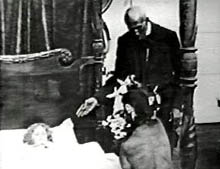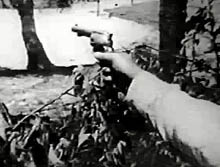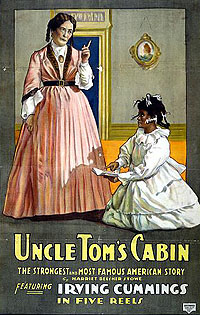  |
This film, released 10 August 1914, was not only much longer than the previous silent versions of Stowe's novel; it was also the first film to feature an African-American actor, Sam Lucas, in the role of Uncle Tom. This may even be the first American film of any kind to "star" an African American. Since 1880, Lucas had played Tom onstage hundreds if not thousands of times, and was one of the few performers identified by name on ADVERTISING POSTERS for the plays. Curiously, although he is often at the center of the camera's attention, in the entire course of the movie Tom only "speaks" in one title, just before he dies. The film is interesting for a number of reasons, including the way the camera often puts viewers into the position of a slave (and strikingly so at the end, when a young slave kills Simon Legree), the way its location shots give it a much greater air of authenticity than previous films (which often rely on stage sets), and the way it shows the permeability of the "Tom story" to other entertainment forms by clearly including a number of elements from the new popular genre of western movies throughout. Marie (or Mary) Eline, famous as the "Thanhouser Kid," had also played Eva for Thanhouser in that studio's 1910 movie. |
| The running time for this film is over forty minutes. Almost all of it is viewable HERE. | |
 Lobby Poster |
Credits: Cast: Sam Lucas (Uncle Tom), Walter Hitchcock (George Shelby), Hattie Delaro (Mrs. Shelby), Master Abernathy (George Shelby, Jr.), Teresa Michelena (Eliza), Irving Cummings (George Harris), Paul Scardon (Haley), Marie Eline (Little Eva St. Clair), Garfield Thompson (St. Clair), Roy Applegate (Simon Legree), Boots Wall (Topsy). |
|
The Evening Post (22 August 1914) The New York Times (23 August 1914) The Washington Post (30 August 1914) The Los Angeles Times (8 September 1914) The Los Angeles Times (20 September 1914) The Washington Post (22 September 1914) In the late 1920s the film was slightly re-edited and released for home viewing, and
the version of the film available here has been digitized from a copy of that
version. In the re-editing, one scene (with Jim Vance's mother) seems to have
been cut and a few new explanatory titles
were added. You can compare the original titles and those in the version
available here with these links: Because of the film's length, the playable clips include some abridgements, though every twentieth frame of the whole film is available in the slideshow versions. GO TO FILM |
